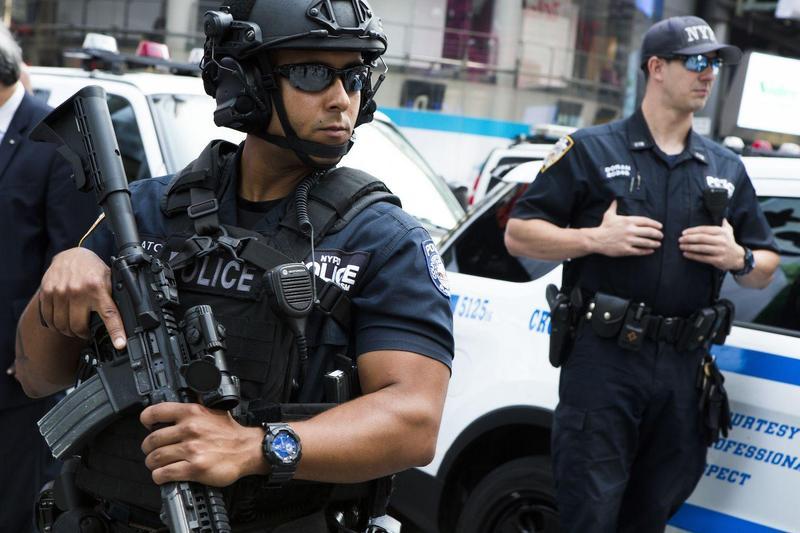Bringing Meditation to the New York Police
Bringing Meditation to the New York Police
Earlier this month, the New York City Police Department became the largest police force in the United States to get on board with the newest trend sweeping law enforcement sections: mindfulness meditation. Reverend Qalvy Grainzvolt, lead meditation guide at The Shinnyo Center for Meditation and Well-being, is training officers at the New York City Police Academy to provide basic meditation practices for their peers. The meditation block is part of the Crisis Intervention Team training that’s required of all of the roughly 36,000 officers on the force.
”, they’re going to come across homeless people, criminals, people protesting the political landscape. If they can be in touch with their authenticity, their strength, their empathy, their compassion, to me that can only be a win-win situation,” Grainzvolt informed Tricycle when requested about the advantages of meditation in law enforcement.
Police departments throughout the nation have been turning to meditation to assist officers manage stress and increase resiliency at work which frequently contributes to poor physical and mental health outcomes. Cities such as Madison, Wisconsin, Tempe, Arizona, and Hillsboro, Oregon, provide meditation training for their officers. After five officers were shot and murdered in Dallas in 2016, the Dallas Police Department obtained a donation that has enabled hundreds of officers to experience a cognitive and mindfulness mind training plan known as Strategic Memory Advanced Reasoning Training (SMART), the Dallas News reported. And the New York City Department of Correction has been offering meditation to correction officers who operate on Rikers Island since 2016.
Grainzvolt, who served in the National Guard before joining the Shinnyo-en Buddhist order, traces his interest in wanting to work with police officers back to 2015, when a group of over 125 Buddhist leaders met with government officials at the White House. Grainzvolt remembered two petitions circulating at the historical meeting: one against nuclear proliferation and another against police brutality.
“When I read the petition on police brutality, it struck me as a little too polarizing … Yes, there are bad apples, but I’m not sure the way to solve a problem is to demonize everyone, and that was sort of the tone of it. So I was really trying to think: What can I do? Should I do nothing? Or can I work from within?”
Grainzvolt believed he can be of service teaching meditation to officers. His initial step was going through the Citizens Police Academy, a 10-week course that teaches a condensed version of NYPD training. Grainzvolt graduated at the top of his class in December 2016, and his valedictorian speech caught the ear of then-NYPD Transit Chief Joe Fox.
“When I heard him speak I just got connected to him; I never met him before,” said Fox, who retired January 2018 after 36 years on the force. “Here’s a man at an NYPD ceremony, with the chief [and other top officials sitting behind him, who started by saying, ‘I want to let everyone know how beautiful your smiles look now.’”
The chief and the priest exchanged information, and Grainzvolt soon began offering meditation assignments to Transit Bureau officers and civilian employees. During such periods, Grainzvolt stated he strove to “dispel the myth” that meditation could only be done in a quiet area, and taught that the hustle and bustle of New York City could be used to “cultivate compassion, mindfulness, and sensitivity to others.”
Grainzvolt stated it was also important to him that the meditation instruction given was not just about stress management–“do this so you can do that better”–and rather provides officers with the resources to boost their own awareness.
Fox stated he never would have thought to offer meditation instruction to his team had he not met Grainzvolt, and said the workshops had been one of those “best things to happen in the Transit Bureau.”
“Our brains are in many ways wired to protect us from threat … velcro for bad thoughts, teflon for good thoughts,” Fox stated, remembering a recent meditation instruction he heard. “In policing, we need to be cautious, aware, and safe, but we also need to be able to turn that switch off.”
Grainzvolt’s experience leading the Transit Bureau employees in meditation, combined with another connection–a Shinnyo Center practitioner and social worker who instructs deescalation methods to NYPD trainees–headed to some year-long vetting procedure for the Police Academy gig. Grainzvolt formally started offering meditation at the Police Academy at College Point, Queens, at the end of January.
Source: Tricycle
For policemen with their hard work, ways must be found to relieve tension. Yoga and meditation can help them a lot. An old friend of mine has worked half his life in law enforcement. How many years I have known him, I constantly see how his work leaves a mark on him. For a while, he even became addicted to alcohol, since my friends and I were able to pull him out of this abyss. Then I told him about meditation, that it can help, he trusted me and now, two years later, he does nothing but relieve the tension during meditation.
